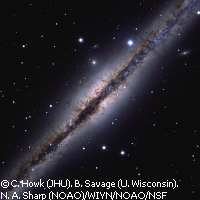New model helps to calculate energy output of stars
An international team of astronomers has calculated the total energy output of all the stars in the universe. The researchers also found that around half of the energy emitted by stars is absorbed by dust particles floating in the vast expanses of space within the galaxies. Their findings have implications for our understanding of how galaxies are born and evolve. The observations are based on a new model developed by Dr Cristina Popescu of the University of Central Lancashire in the UK and Dr Richard Tuffs of the Max Planck Institute for Nuclear Physics in Heidelberg, Germany. The model describes how dust particles are distributed in relation to stars and disks of galaxies and, by calculating the dimming effect of the dust, makes it possible to predict the difference between the total light emitted by the stars and the total light inferred from observations. An average star at a random position in the universe generates about 40 quadrillion kilowatthours in one year. This amounts to 300 times humankind's current energy consumption needs. Similar to smoke in the Earth's atmosphere, dust particles absorb large parts of the energy emitted by stars. Of course, the energy is not lost, but it heats the dust particles, which emit heat radiation as a result. This heat radiation can be detected in the infrared part of the electromagnetic spectrum. The amount of energy absorbed by the particles is determined by their position in relation to the stars, which is why the model developed by Dr Popescu and Dr Tuffs has greatly helped the understanding of the phenomenon. In previous calculations, the infrared emissions of dust sometimes seemed to surpass estimates of total starlight emitted. 'You can't get more energy out than you put in - we knew that something wasn't quite right there,' team leader Dr Simon Driver of the University of St Andrews, UK, explains. A paradox that the new model has resolved. 'The fact that the observations so closely matched the predictions make us confident that we really now understand the radiation of energy from galaxies and thereby from the universe as a whole over a wide range of wavelengths,' says Dr Popescu. 'The results very clearly show that interstellar dust particles have a very pronounced effect on the observed starlight from galaxies in the local universe,' adds Dr Tuffs. The researchers hope to soon get an even more detailed picture of individual galaxies with the help of two new facilities due to be up and running in the coming months, namely the VISTA telescope in Chile and 'Herschel', the European Space Agency's (ESA's) infrared space observatory. 'VISTA will allow us to see further through the dust, whereas Herschel will directly detect the emission from the dust,' says Dr Jochen Liske of the European Southern Observatory.
Countries
Australia, Germany, United Kingdom



